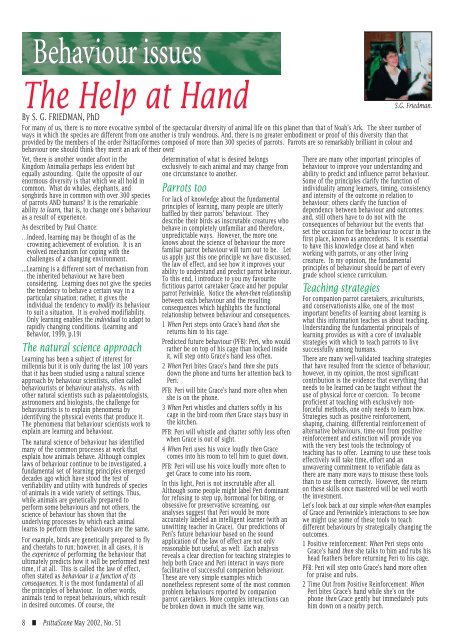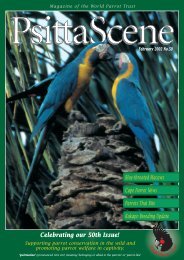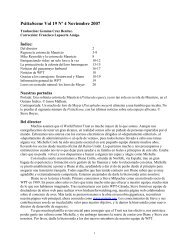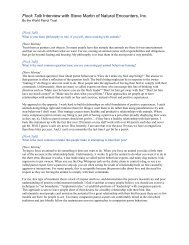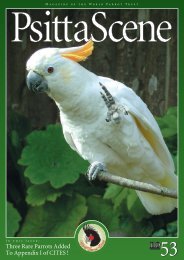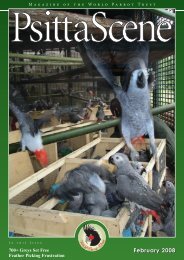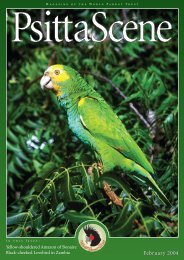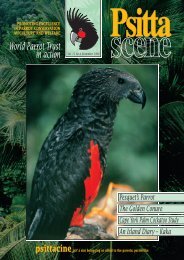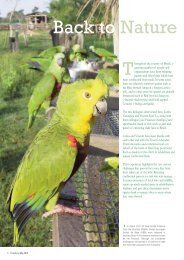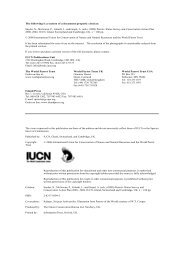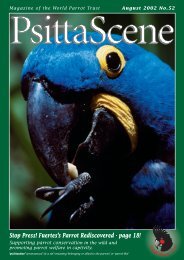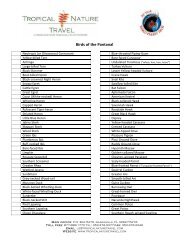Parrots in the Wild - World Parrot Trust
Parrots in the Wild - World Parrot Trust
Parrots in the Wild - World Parrot Trust
You also want an ePaper? Increase the reach of your titles
YUMPU automatically turns print PDFs into web optimized ePapers that Google loves.
Behaviour issues<br />
The Help at Hand<br />
By S. G. FRIEDMAN, PhD<br />
For many of us, <strong>the</strong>re is no more evocative symbol of <strong>the</strong> spectacular diversity of animal life on this planet than that of Noah's Ark. The sheer number of<br />
ways <strong>in</strong> which <strong>the</strong> species are different from one ano<strong>the</strong>r is truly wondrous. And, <strong>the</strong>re is no greater embodiment or proof of this diversity than that<br />
provided by <strong>the</strong> members of <strong>the</strong> order Psittaciformes composed of more than 300 species of parrots. <strong><strong>Parrot</strong>s</strong> are so remarkably brilliant <strong>in</strong> colour and<br />
S.G. Friedman.<br />
behaviour one should th<strong>in</strong>k <strong>the</strong>y merit an ark of <strong>the</strong>ir own!<br />
Yet, <strong>the</strong>re is ano<strong>the</strong>r wonder afoot <strong>in</strong> <strong>the</strong><br />
K<strong>in</strong>gdom Animalia perhaps less evident but<br />
equally astound<strong>in</strong>g. Quite <strong>the</strong> opposite of our<br />
enormous diversity is that which we all hold <strong>in</strong><br />
common. What do whales, elephants, and<br />
songbirds have <strong>in</strong> common with over 300 species<br />
of parrots AND humans? It is <strong>the</strong> remarkable<br />
ability to learn, that is, to change one's behaviour<br />
as a result of experience.<br />
As described by Paul Chance:<br />
…Indeed, learn<strong>in</strong>g may be thought of as <strong>the</strong><br />
crown<strong>in</strong>g achievement of evolution. It is an<br />
evolved mechanism for cop<strong>in</strong>g with <strong>the</strong><br />
challenges of a chang<strong>in</strong>g environment.<br />
...Learn<strong>in</strong>g is a different sort of mechanism from<br />
<strong>the</strong> <strong>in</strong>herited behaviour we have been<br />
consider<strong>in</strong>g. Learn<strong>in</strong>g does not give <strong>the</strong> species<br />
<strong>the</strong> tendency to behave a certa<strong>in</strong> way <strong>in</strong> a<br />
particular situation; ra<strong>the</strong>r, it gives <strong>the</strong><br />
<strong>in</strong>dividual <strong>the</strong> tendency to modify its behaviour<br />
to suit a situation. It is evolved modifiability.<br />
Only learn<strong>in</strong>g enables <strong>the</strong> <strong>in</strong>dividual to adapt to<br />
rapidly chang<strong>in</strong>g conditions. (Learn<strong>in</strong>g and<br />
Behavior, 1999, p.19)<br />
The natural science approach<br />
Learn<strong>in</strong>g has been a subject of <strong>in</strong>terest for<br />
millennia but it is only dur<strong>in</strong>g <strong>the</strong> last 100 years<br />
that it has been studied us<strong>in</strong>g a natural science<br />
approach by behaviour scientists, often called<br />
behaviourists or behaviour analysts. As with<br />
o<strong>the</strong>r natural scientists such as palaeontologists,<br />
astronomers and biologists, <strong>the</strong> challenge for<br />
behaviourists is to expla<strong>in</strong> phenomena by<br />
identify<strong>in</strong>g <strong>the</strong> physical events that produce it.<br />
The phenomena that behaviour scientists work to<br />
expla<strong>in</strong> are learn<strong>in</strong>g and behaviour.<br />
The natural science of behaviour has identified<br />
many of <strong>the</strong> common processes at work that<br />
expla<strong>in</strong> how animals behave. Although complex<br />
laws of behaviour cont<strong>in</strong>ue to be <strong>in</strong>vestigated, a<br />
fundamental set of learn<strong>in</strong>g pr<strong>in</strong>ciples emerged<br />
decades ago which have stood <strong>the</strong> test of<br />
verifiability and utility with hundreds of species<br />
of animals <strong>in</strong> a wide variety of sett<strong>in</strong>gs. Thus,<br />
while animals are genetically prepared to<br />
perform some behaviours and not o<strong>the</strong>rs, <strong>the</strong><br />
science of behaviour has shown that <strong>the</strong><br />
underly<strong>in</strong>g processes by which each animal<br />
learns to perform <strong>the</strong>se behaviours are <strong>the</strong> same.<br />
For example, birds are genetically prepared to fly<br />
and cheetahs to run; however, <strong>in</strong> all cases, it is<br />
<strong>the</strong> experience of perform<strong>in</strong>g <strong>the</strong> behaviour that<br />
ultimately predicts how it will be performed next<br />
time, if at all. This is called <strong>the</strong> law of effect,<br />
often stated as behaviour is a function of its<br />
consequences. It is <strong>the</strong> most fundamental of all<br />
<strong>the</strong> pr<strong>in</strong>ciples of behaviour. In o<strong>the</strong>r words,<br />
animals tend to repeat behaviours, which result<br />
<strong>in</strong> desired outcomes. Of course, <strong>the</strong><br />
determ<strong>in</strong>ation of what is desired belongs<br />
exclusively to each animal and may change from<br />
one circumstance to ano<strong>the</strong>r.<br />
<strong><strong>Parrot</strong>s</strong> too<br />
For lack of knowledge about <strong>the</strong> fundamental<br />
pr<strong>in</strong>ciples of learn<strong>in</strong>g, many people are utterly<br />
baffled by <strong>the</strong>ir parrots' behaviour. They<br />
describe <strong>the</strong>ir birds as <strong>in</strong>scrutable creatures who<br />
behave <strong>in</strong> completely unfamiliar and <strong>the</strong>refore,<br />
unpredictable ways. However, <strong>the</strong> more one<br />
knows about <strong>the</strong> science of behaviour <strong>the</strong> more<br />
familiar parrot behaviour will turn out to be. Let<br />
us apply just this one pr<strong>in</strong>ciple we have discussed,<br />
<strong>the</strong> law of effect, and see how it improves your<br />
ability to understand and predict parrot behaviour.<br />
To this end, I <strong>in</strong>troduce to you my favourite<br />
fictitious parrot caretaker Grace and her popular<br />
parrot Periw<strong>in</strong>kle. Notice <strong>the</strong> when-<strong>the</strong>n relationship<br />
between each behaviour and <strong>the</strong> result<strong>in</strong>g<br />
consequences which highlights <strong>the</strong> functional<br />
relationship between behaviour and consequences.<br />
1 When Peri steps onto Grace's hand <strong>the</strong>n she<br />
returns him to his cage.<br />
Predicted future behaviour (PFB): Peri, who would<br />
ra<strong>the</strong>r be on top of his cage than locked <strong>in</strong>side<br />
it, will step onto Grace's hand less often.<br />
2 When Peri bites Grace's hand <strong>the</strong>n she puts<br />
down <strong>the</strong> phone and turns her attention back to<br />
Peri.<br />
PFB: Peri will bite Grace's hand more often when<br />
she is on <strong>the</strong> phone.<br />
3 When Peri whistles and chatters softly <strong>in</strong> his<br />
cage <strong>in</strong> <strong>the</strong> bird-room <strong>the</strong>n Grace stays busy <strong>in</strong><br />
<strong>the</strong> kitchen.<br />
PFB: Peri will whistle and chatter softly less often<br />
when Grace is out of sight.<br />
4 When Peri uses his voice loudly <strong>the</strong>n Grace<br />
comes <strong>in</strong>to his room to tell him to quiet down.<br />
PFB: Peri will use his voice loudly more often to<br />
get Grace to come <strong>in</strong>to his room.<br />
In this light, Peri is not <strong>in</strong>scrutable after all.<br />
Although some people might label Peri dom<strong>in</strong>ant<br />
for refus<strong>in</strong>g to step up, hormonal for bit<strong>in</strong>g, or<br />
obsessive for preservative scream<strong>in</strong>g, our<br />
analyses suggest that Peri would be more<br />
accurately labeled an <strong>in</strong>telligent learner (with an<br />
unwitt<strong>in</strong>g teacher <strong>in</strong> Grace). Our predictions of<br />
Peri's future behaviour based on <strong>the</strong> sound<br />
application of <strong>the</strong> law of effect are not only<br />
reasonable but useful, as well: Each analysis<br />
reveals a clear direction for teach<strong>in</strong>g strategies to<br />
help both Grace and Peri <strong>in</strong>teract <strong>in</strong> ways more<br />
facilitative of successful companion behaviour.<br />
These are very simple examples which<br />
none<strong>the</strong>less represent some of <strong>the</strong> most common<br />
problem behaviours reported by companion<br />
parrot caretakers. More complex <strong>in</strong>teractions can<br />
be broken down <strong>in</strong> much <strong>the</strong> same way.<br />
There are many o<strong>the</strong>r important pr<strong>in</strong>ciples of<br />
behaviour to improve your understand<strong>in</strong>g and<br />
ability to predict and <strong>in</strong>fluence parrot behaviour.<br />
Some of <strong>the</strong> pr<strong>in</strong>ciples clarify <strong>the</strong> function of<br />
<strong>in</strong>dividuality among learners, tim<strong>in</strong>g, consistency<br />
and <strong>in</strong>tensity of <strong>the</strong> outcome <strong>in</strong> relation to<br />
behaviour; o<strong>the</strong>rs clarify <strong>the</strong> function of<br />
dependency between behaviour and outcomes;<br />
and, still o<strong>the</strong>rs have to do not with <strong>the</strong><br />
consequences of behaviour but <strong>the</strong> events that<br />
set <strong>the</strong> occasion for <strong>the</strong> behaviour to occur <strong>in</strong> <strong>the</strong><br />
first place, known as antecedents. It is essential<br />
to have this knowledge close at hand when<br />
work<strong>in</strong>g with parrots, or any o<strong>the</strong>r liv<strong>in</strong>g<br />
creature. In my op<strong>in</strong>ion, <strong>the</strong> fundamental<br />
pr<strong>in</strong>ciples of behaviour should be part of every<br />
grade school science curriculum.<br />
Teach<strong>in</strong>g strategies<br />
For companion parrot caretakers, aviculturists,<br />
and conservationists alike, one of <strong>the</strong> most<br />
important benefits of learn<strong>in</strong>g about learn<strong>in</strong>g is<br />
what this <strong>in</strong>formation teaches us about teach<strong>in</strong>g.<br />
Understand<strong>in</strong>g <strong>the</strong> fundamental pr<strong>in</strong>cipals of<br />
learn<strong>in</strong>g provides us with a core of <strong>in</strong>valuable<br />
strategies with which to teach parrots to live<br />
successfully among humans.<br />
There are many well-validated teach<strong>in</strong>g strategies<br />
that have resulted from <strong>the</strong> science of behaviour;<br />
however, <strong>in</strong> my op<strong>in</strong>ion, <strong>the</strong> most significant<br />
contribution is <strong>the</strong> evidence that everyth<strong>in</strong>g that<br />
needs to be learned can be taught without <strong>the</strong><br />
use of physical force or coercion. To become<br />
proficient at teach<strong>in</strong>g with exclusively nonforceful<br />
methods, one only needs to learn how.<br />
Strategies such as positive re<strong>in</strong>forcement,<br />
shap<strong>in</strong>g, cha<strong>in</strong><strong>in</strong>g, differential re<strong>in</strong>forcement of<br />
alternative behaviours, time-out from positive<br />
re<strong>in</strong>forcement and ext<strong>in</strong>ction will provide you<br />
with <strong>the</strong> very best tools <strong>the</strong> technology of<br />
teach<strong>in</strong>g has to offer. Learn<strong>in</strong>g to use <strong>the</strong>se tools<br />
effectively will take time, effort and an<br />
unwaver<strong>in</strong>g commitment to verifiable data as<br />
<strong>the</strong>re are many more ways to misuse <strong>the</strong>se tools<br />
than to use <strong>the</strong>m correctly. However, <strong>the</strong> return<br />
on <strong>the</strong>se skills once mastered will be well worth<br />
<strong>the</strong> <strong>in</strong>vestment.<br />
Let's look back at our simple when-<strong>the</strong>n examples<br />
of Grace and Periw<strong>in</strong>kle's <strong>in</strong>teractions to see how<br />
we might use some of <strong>the</strong>se tools to teach<br />
different behaviours by strategically chang<strong>in</strong>g <strong>the</strong><br />
outcomes.<br />
1 Positive re<strong>in</strong>forcement: When Peri steps onto<br />
Grace's hand <strong>the</strong>n she talks to him and rubs his<br />
head fea<strong>the</strong>rs before return<strong>in</strong>g Peri to his cage.<br />
PFB: Peri will step onto Grace's hand more often<br />
for praise and rubs.<br />
2 Time Out from Positive Re<strong>in</strong>forcement: When<br />
Peri bites Grace's hand while she's on <strong>the</strong><br />
phone <strong>the</strong>n Grace gently but immediately puts<br />
him down on a nearby perch.<br />
8 ■ PsittaScene May 2002, No. 51


